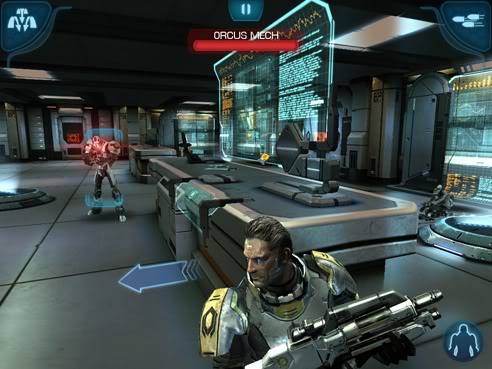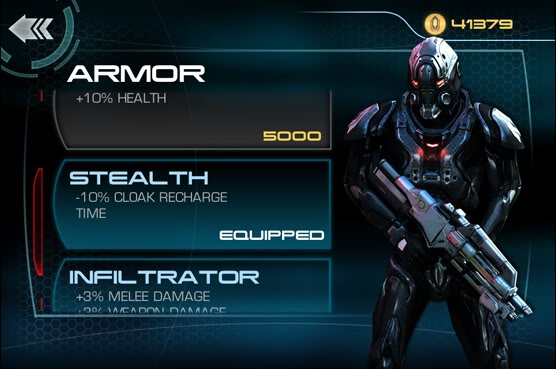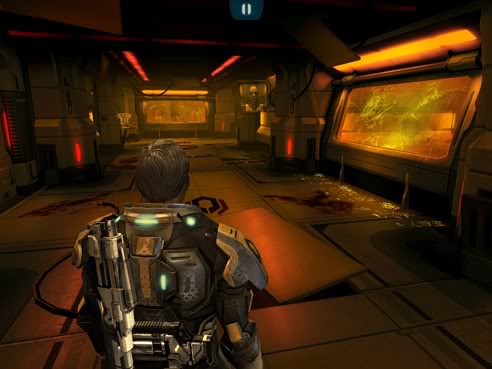When it comes to franchises we’re invested in, some of us have a pathological need to make sure we don’t miss out on the full experience; we find ourselves helplessly drawn to questionable tie-in media. That’s what EA is counting on with Mass Effect: Infiltrator, the iOS cover-based shooter released in concert with Mass Effect 3.
In Infiltrator, players take on the role of extensively modified Cerberus operative Randall Enzo in a quest to save his friend from his employer. So, does Infiltrator add to the already expansive fiction of the Mass Effect universe? Is it worth playing as a standalone experience?
If you played Dead Space iOS last year, you can already answer the second question for yourself. EA’s Iron Monkey Studios developed both games. That’s not to say they haven’t learned anything in the intervening time. Infiltrator feels more polished, both graphically and mechanically. The space fly-throughs in occasional cut scenes look especially nice. Add recognizable (if a bit repetitive) tunes and the atmosphere screams Mass Effect. It ran relatively smoothly on my iPhone 4 with iOS 5.1 installed; I never ran into any crashes or game-hindering hiccups.
In an apparent admission that touch controls don’t allow responsive shooting, Iron Monkey replaced necromorph dismemberment with a combo based damage system. I found this initially counterintuitive, but it clicked once I realized I had to discard my preconceptions brought on by the cover-shooter veneer.

The game certainly looks like Mass Effect
The combo system provides more damage and greater rewards for chaining attacks together. The player can tap an enemy within weapon range to start auto-firing the equipped weapon. While the weapon fires, the player swipes around to aim more precisely, usually at the head (the exception, bosses, have obvious weak points). When an enemy goes down, quickly targeting successive enemies in range drastically amplifies damage and remits style points that add to the final score for each section.
In the early going, I ran into some trouble with the shotgun: the delay between shots made me instinctively tap to fire rather than waiting for auto-fire. However, tapping causes Randall to leave targeting mode, breaking the combo. This came in contrast to my favored sniper rifle, which can’t combo but requires a tap to fire. Eventually, I got the hang of it, but not without some cursing.
Players get a possible three star rating in three areas: time, health, and style. While the first two are self-explanatory, style points go up with successful combos and for using a different weapon for each successive kill. Failing to change weapons from one kill to the next (outside combos) actually subtracts style points. In this way Iron Monkey has cleverly wedged in a bit of artificial difficulty. I often found myself trying to close distance on a Nemesis sniper to take her out with a short range weapon when I could have much more easily sniped her… at the cost of style points.
Score translates to credits that, in turn, translate to upgrades. In true app store fashion, the game allows for credit purchases with real money. This may seem crazy on top of a $7 game, but the implementation almost seems designed to discourage additional purchases. From of $2 for 2,500 credits (enough for several low-level upgrades or one mid-level) to $50 for 200,000 credits, the options range from easily achievable in a few minutes of play to so absurdly overpriced that the any buyers deserve what they get.
None of the load screen tips I’ve seen ever suggest buying credits but do provide gameplay tips to earn them faster. All this makes it look like the in-app purchase option got a perfunctory treatment because somebody, at some level, required it. No doubt it will make some money, but I never felt pressured to use the feature; the game’s balanced challenge just doesn’t incentivize it.

I never had 41,379 credits, but I never needed that much either
I should also mention here that linking your Origin account allows you to affect your galactic readiness rating in ME3. Enemies drop intel which is also doled out for completing the game. Players can trade intel for credits, but it goes to better use when uploaded to Alliance Command. After playing the game and completing it normally (about 5 hours), I uploaded all my intel to find my rating up 10 percent in all sectors. New game + and a level select option allow for intel grinding, if you’re into that. While ME3 multiplayer also increases readiness, I haven’t played any since the demo, so I can’t comment on its relative efficiency.
That the combo system forms the backbone of the challenge is a credit to the developer. Infiltrator suffers from the inevitable finicky nature of touch based titles. I ran into quite enough near-phone-throwing-frustration without overly difficult enemies to contend with. Allowing me to challenge myself struck a kind of balance.
While the game certainly has some tense situations brought on by waves of flanking baddies, it never reaches totally unreasonable levels. It echoes the feeling of ME3’s pitched battles expertly, in this respect. Unfortunately, I found myself taking cover when I meant to roll or run even more often than I do in ME3 (which is a lot). That a common problem caused by mapping so many actions to the same button gets even worse with no buttons should surprise no one.
Infiltrator continuously reminds the player it’s Mass Effect for both good and ill. Suddenly realizing I could acquire credits through terminals and wall safes brought a little thrill of recognition. Likewise, the introduction of each new enemy type and combat power further solidifies the feeling of being in the ME galaxy. Just like in ME3, biotic pull handily thwarts Cerberus Guardians by stripping their shields. Unfortunately, story elements don’t make the jump to iOS intact.
From time to time, Randall will come across rooms with frightened non-combatants. Paragon and Renegade icons appear on the screen with no hint at what will happen. It soon becomes clear why: every one of these events, often carbon copies of previous ones, boils down to “let them go or kill them.” As far as I could tell, the in-game consequences of these choices never materialized.
It seems any ME game would require player driven dialog, but Infiltrator has none. In its place, scripted conversations trot out an extremely by-the-numbers story of betrayal to reinforce the irredeemable nastiness of Cerberus. This throws the fact that Iron Monkey doesn’t have Bioware’s writers into sharp relief.

The guy on the screen is talking to Randall, not you
That’s the rub. If you’re worrying you’ll miss out on the full Mass Effect experience by not playing Infiltrator, put that out of your mind. The story barely exists. I can safely say a player that skips it misses nothing but a particularly long, flavorless side quest. The occasionally accurate reflection of the ME aesthetic only serves as a reminder of what could be.
Despite the requisite flaws of a touch based action title, Infiltrator provides a solid and enjoyable iOS combat experience. But that’s all it provides. As such, I can’t recommend it to the core Mass Effect audience.